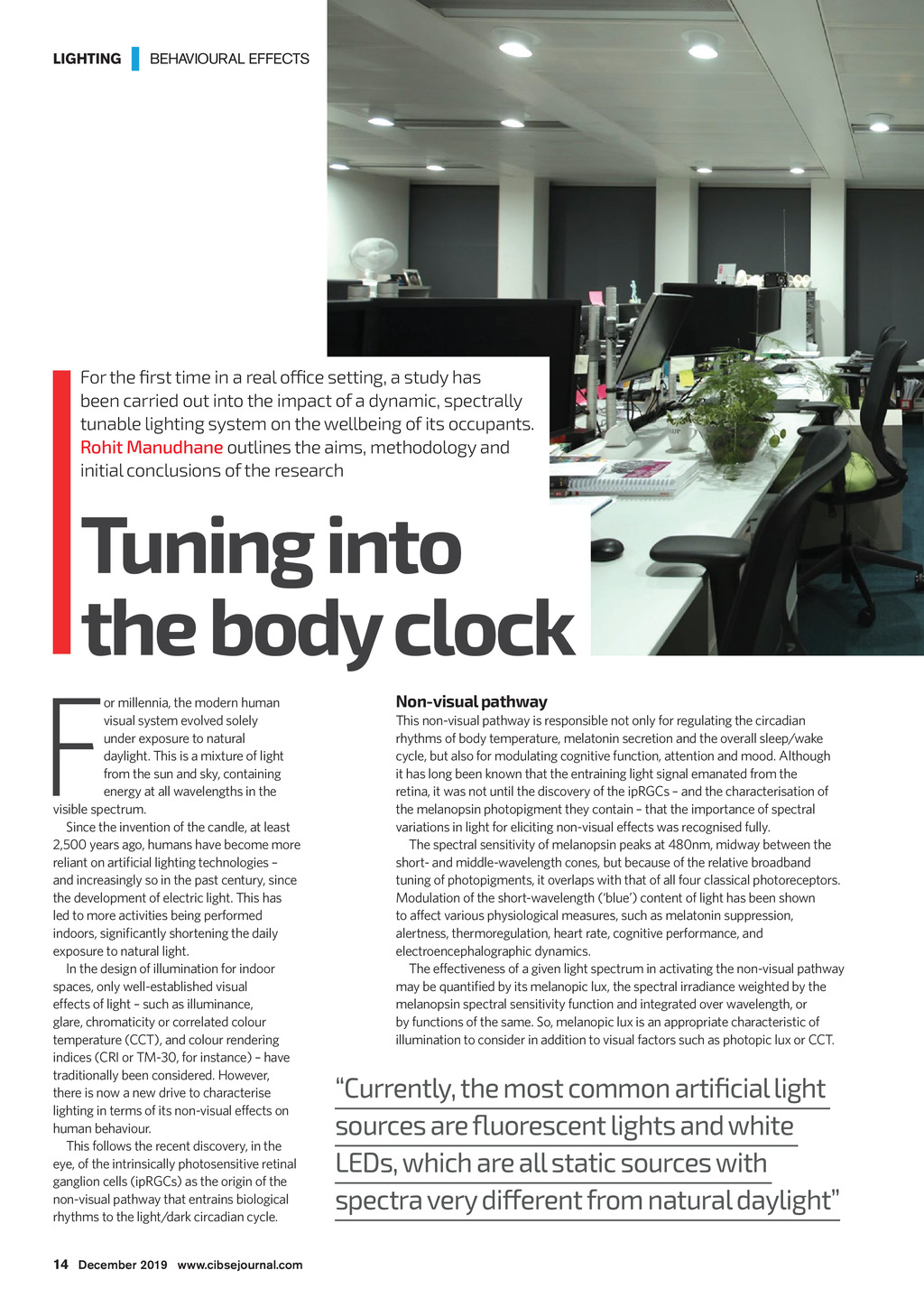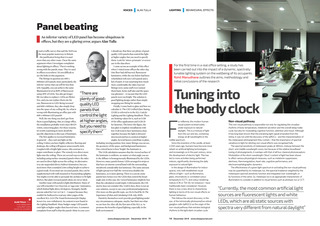




VOICES | ALAN TULLA Panel beating An inferior variety of LED panel has become ubiquitous in ofces, but they are a glaring error, argues Alan Tulla I read a traffic survey that said the M25 was the most popular motorway in Britain the justification being that it is used more than any other route. I hear the same argument when I investigate complaints about lighting in offices. Theres nothing wrong with the panels, mate. Theyre used in offices everywhere. Its not difficult to see the holes in this argument. The fittings in question are 600 x 600mm LED panels; more particularly, the inferior variety that can sell for less than 30. Arguably, you can achieve the same illumination level as 80W of fluorescent using 35W of LEDs. You also get longer life (no tubes to replace), LEDs are flicker free, and you can replace them one for one, fluorescent to LED. Being recessed and 600 x 600mm, they also simply drop into the space of any ceiling tile. So, what is wrong with illuminating an office just with 600 x 600mm LED panels? Well, the one thing you dont get from them is good lighting. Also, in a large office, the installation probably wont meet BS EN 12464, concerning glare. For these reasons, its worth examining in more detail the specific objections to this type of luminaire. The first applies to recessed luminaires in general they cant put light on the ceiling. Unless you have highly reflective flooring and desktops, the ceiling will appear unnecessarily dark. Coupled with a bright light source, this contrast is a major contributor to glare. The remedy is to direct more light onto the ceiling. There are several ways to do this, including using surface-mounted panels where the sides are used to direct light across the ceiling. An alternative is to use suspended direct/indirect luminaires, but you need more than a standard 2.5m ceiling height to achieve a good result. If you must use recessed panels, they can be supplemented with wall-mounted or freestanding uplights. You might even be able to persuade the architect to fit light shelves. But plain recessed panels alone are never ideal. Another issue with panels is light distribution. Many of you will remember Cat 2 louvred, or egg crate, luminaires, which limited light above 65 degrees. Strangely, hardly anyone asked for Cat 1 or Cat 3 I suspect because they couldnt be bothered to read any other pages of the excellent SLL LG3 (The Visual Environment for Display Screen Use, now withdrawn). Its content is now found in the Lighting Handbook. Many budget-range LED panels emit light at higher angles than louvred ones. A common complaint from staff is that the panels shine in your eyes. I should say that there are plenty of goodquality LED panels that control the light at higher angles, but you need to specify them. Look for micro-prismatic or screen use in the data sheet. I came across an example of this effect when I visited some offices the other day. One floor had old louvred, fluorescent luminaires, while the one below had been refurbished with new LED panels and a lick of paint. It was surprising how much more comfortable the older, louvred fittings were; some staff even wanted them back. Some staff also said the space was gloomier it was just that the LED panels were too bright. The solution is good lighting design rather than simply swapping one fitting for another. Finally, I come back to glare and how we calculate it. The CIE Unified Glare Rating (UGR) is referred to in the SLL Code for Lighting and the Lighting Handbook. There are limiting values for it, such as UGR 19 for office applications and UGR 25 for factories. The lower the figure, the less glare is implied. Installations with low UGR tend to have luminaires close together, because the light is directed downward and less is emitted at higher angles. Several factors contribute to glare, including viewing position, how many fittings you can see, the geometry of the space, and background luminance. One critical factor is how bright the luminaire is. The UGR calculation assumes that the viewed surface of the luminaire is uniform, no matter at what angle you see it: the diffuser is homogeneously illuminated by the LEDs. However, many panels feature LEDs arranged in strips or that have an intense central band with the surrounding metalwork considerably less luminous. The same amount of light spread over half the viewed area doubles the luminance, so is more glaring. There is a caveat: some panels have lenses over the LEDs that control the beam angle and, in this case, the viewed luminance might be less than the calculation would imply. Unfortunately, the CIE metric does not consider this. Until it does, there is not an easy solution, except to use your professional judgement. (For more on this specific topic, see SLLs FactFile 15: The Importance of Glare and Calculating UGR, July 2019). Panels by themselves wont provide good lighting under any circumstances; adequate, maybe, but thats not what we are here for. After all, the first aim of the SLL is, to promote the benefits of good lighting, especially in the built environment. There are plenty of goodquality LED panels that control the light at higher angles, but you need to specify them ALAN TULLA, FSLL, is an independent consultant, and a former SLL president www.cibsejournal.com December 2019 11 CIBSE Dec19 pp11 Alan Tulla Supp.indd 11 22/11/2019 17:05